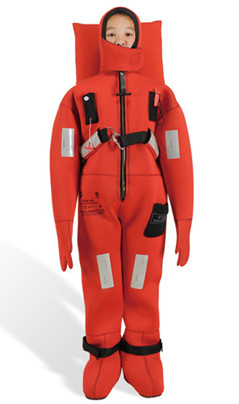Life-saving appliances are essential safety equipment designed to protect individuals in emergencies, especially at sea where conditions can quickly become dangerous. From lifeboats and life vests to survival suits, these devices are created with one primary goal: to save lives. Among these, the immersion survival suit is one of the most critical life-saving appliances for maritime safety. When deployed in freezing or turbulent waters, an immersion survival suit can mean the difference between survival and hypothermia. Understanding how these suits work and why they’re essential can help mariners, fishermen, and offshore workers better prepare for potential emergencies.
What Is an Immersion Survival Suit?
An immersion survival suit, also known as a survival or exposure suit, is a specialized, waterproof garment designed to protect the wearer from the cold shock and hypothermia associated with sudden immersion in cold water. These suits are typically made of materials like neoprene or PVC-coated fabrics, which provide insulation and prevent water ingress. Unlike regular clothing, which absorbs water and exacerbates heat loss, immersion suits are designed to retain body heat, offering flotation and insulation that can keep a person alive for hours. The suit’s bright colors and reflective patches also make it easier for rescuers to locate individuals in the water, further enhancing its role as a life-saving appliance.
How Immersion Survival Suits Protect Against Hypothermia
One of the most dangerous threats to survival in cold water is hypothermia, which can set in within minutes. The immersion survival suit combats this by trapping a thin layer of water between the suit and the body, which then warms up to the body’s temperature and provides insulation. This design reduces the rapid heat loss that occurs when a person is directly exposed to cold water. Additionally, the suit’s waterproof properties prevent water from continuously washing away body heat, ensuring the wearer stays as warm as possible. By minimizing heat loss, immersion suits significantly increase survival time, giving rescue teams valuable time to locate and retrieve individuals safely.
Features That Make Immersion Survival Suits Effective Life-Saving Appliances
The best immersion survival suits come with a range of features tailored to enhance their functionality as life-saving appliances. These include watertight seals around the wrists, ankles, and neck, which prevent water from entering the suit. Many suits also have integrated flotation devices or buoyancy aids, keeping the wearer’s head above water and ensuring they remain afloat even if unconscious. Furthermore, immersion suits are made in bright colors, such as orange or red, and have reflective tape to improve visibility in low-light conditions. Some suits even include a whistle or a locator beacon to further aid in rescue efforts.
Why Every Seafarer Needs an Immersion Survival Suit
For anyone who spends extended time at sea, especially in cold regions, an immersion survival suit is a crucial life-saving appliance. Mariners, fishermen, and offshore workers all face the risk of accidental immersion, whether due to harsh weather, vessel damage, or other unexpected events. Having a survival suit on board isn’t just about compliance with maritime regulations; it’s about being prepared for the worst-case scenario. When emergencies arise, there may be little time to act, and having access to an immersion suit can dramatically improve the chances of survival and recovery.
Maintenance and Proper Use of Immersion Survival Suits
Like all life saving appliances, immersion survival suits require regular maintenance to ensure they function effectively in an emergency. Suits should be inspected periodically for any signs of wear, damage, or leaks that could compromise their waterproofing or insulation. Proper training on how to don the suit quickly is also essential, as survival time can be significantly impacted by how fast an individual can get into the suit. Understanding the correct way to store and maintain these suits is key to ensuring they are ready for use when needed most.
Conclusion
In the realm of lifesaving appliances, the immersion survival suit stands out as an indispensable piece of equipment for anyone who ventures out to sea. Its design, tailored for protection against cold water and harsh conditions, makes it essential for survival in emergency situations. By protecting against hypothermia, aiding flotation, and enhancing visibility, immersion survival suits increase the chances of survival for seafarers until help arrives. For anyone working in or traveling through maritime environments, having an immersion survival suit on board is a vital step towards ensuring safety at sea.

